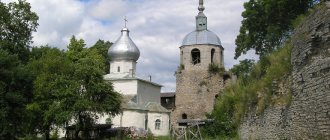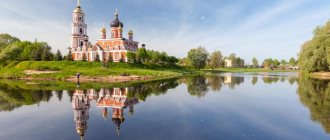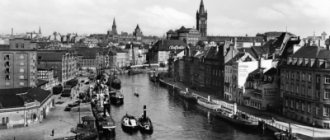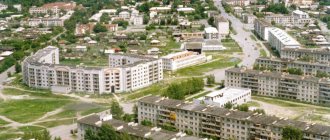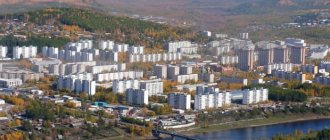25.06.2017
The city of Zelenograd is becoming larger before our eyes, growing not only in territory, but also in the housing stock.
Its popularity is not accidental. Zelenograd is quite a beautiful and comfortable city. The local infrastructure has everything necessary that a modern city dweller might need. Convenient transport also develops with the times. Modern buses, minibuses, electric trains and high-speed trains - all this allows passengers to easily move both within the city and beyond, including to the nearest Moscow metro stations. There are plans to build a light metro in the near future.
Zelenograd is literally a green city. There are a lot of forested areas, shady courtyards, and alleys where you can forget for a while that you are in a large administrative district of Moscow. Yes, exactly Moscow.
Why is it important for future buyers of apartments in Zelenograd to have Moscow registration? Because for many it is very important to live in Moscow, have Moscow social benefits and at the same time be away from the noisy and stuffy center of the capital. Moreover, the cost of an apartment in Zelenograd is somewhat lower than the prices of apartments in many other areas of Moscow.
Story
Zelenograd was founded in 1958 as an unnamed planned city near the village and Kryukovo station on a previously empty forest site, and its architecture and civil layout are inferior to one general's architectural plan (chief architects Igor Rozhin (1956–1963), then Igor Pokrovsky (1963–2002) ), which is noticeably influenced by the garden city movement, the development of Tapiola County in Finland, and new cities in the UK (Harlow and others).
The city was planned as a center for the textile industry. Initially, in 1962, Alexander Shokin (chairman of the State Committee of Electronic Technology, then first Minister of Electronic Technology) proposed changing the direction of the city's future business to electronics. Some researchers of the history of Soviet electronics have mentioned that a similar idea was proposed to the Soviet government by two fugitive engineers from Silicon Valley - Alfred Sarant (better known in Russia as Philip Staros
) and Joel Barr (
Joseph Berg
).
On January 15, 1963 the city received official city status and the name Zelenograd
, and on November 25, 1968 Zelenograd received the status of a Moscow district (one of 30 districts) at the same time.
In 1988, Zelenograd included the former village of Kryukovo, one of the important sites during the Battle of Moscow (October 1941 - January 1942). In Zelenograd and its surroundings there are several monuments to the defenders of Moscow and the heroes of the Great Patriotic War, the most famous of which is Bayonet
The memorial from which the remains of the Unknown Soldier were taken for re-interment in the Kremlin wall in the Alexander Garden in Moscow.
Until 1989, Zelenograd was a de facto closed city in some aspects: it was forbidden to take photographs in the central part of the city, near factories, educational and research institutions, and foreigners were not allowed into the city.
In 1991, Zelenograd was transformed into one of the administrative districts of Moscow.
Everything for future generations
Future innovators and scientists are being raised in Zelenograd. Modern kindergartens, schools and technology parks are being built for the younger generation, playgrounds and sports grounds, football fields are being built en masse, and parks and squares are being spruced up.
Since 2012, three schools with 850 places and three kindergartens with 700 places have been built in ZelAO. Today, another educational institution opened - the first combined school and kindergarten in the district.
The new educational building of school No. 2045 will house classrooms for fifth and sixth grade students and kindergarten groups - the building is designed for 550 children (300 schoolchildren and 250 children).
The kindergarten department has sports and music halls, and special rooms for clubs. Each group cell, equipped with interactive equipment, is a separate block with a locker room, game room, bedroom, toilet and pantry.
The school department has rooms for creativity and technology, a linguistic laboratory, a gym, an assembly hall with a stage, and a school information center. For the extended day group, there is a games room and multipurpose rooms. 150 students will be able to have lunch in the school canteen.
Photo: mos.ru
In the coming years, it is planned to build five more educational facilities for 2,100 places in Zelenograd: two preschool educational institutions and three schools.
Thus, in the 17th microdistrict there will be a school for 1,100 places with an IT training ground and a gym. The educational buildings will be equipped with an information center with a library, a media library and a conference room, laboratory rooms, two gyms, metal and wood processing workshops, two dining halls, and a medical block. Nearby there will be a football field, a field for ball games, a gymnastics complex, an area for passing GTO standards and a running track. And students will be able to study biology not only in theory, but also in practice: for this purpose, the school will allocate an area for growing field and vegetable crops.
In 2022, a children's technology park "Smart Park" was opened at the Moscow Institute of Electronic Technology. During the classes, schoolchildren master the key specializations of Zelenograd: electronics and microelectronics, IT and biotechnology. Children learn the basics of remote control of unmanned aerial vehicles and participate in laboratory work on creating an artificial heart. After training, they will be able to enter specialized universities on preferential terms, and some of the guys will be able to enter into deferred employment contracts with leading companies.
Photo: mos.ru
For active recreation of children and teenagers, a youth and teenage cultural and health center with a rugby stadium was built in Victory Park. In different districts of Zelenograd, a skate park, a workout area, a mini-football field (1150 square meters), an ice skating rink (1200 square meters) with a universal workout area with exercise equipment and a roller skating rink appeared in different areas of Zelenograd. Starting from 2022, every winter a skating rink with artificial ice is installed on Yunost Square. In the future, young residents will have a place to organize auto racing - the reconstruction of the auto-karting track in Nazarievo continues.
Layout: mos.ru
Layout: mos.ru
Layout: mos.ru
Layout: mos.ru
Geography
The Skhodnya River originates in the area of the village of Alabushevo (one of the settlements under the jurisdiction of Zelenograd) and forms two ponds within the city - the Small and Large City Pond.
administrative districts
Zelenograd administrative district is divided into five districts:
- Matushkino (Matushkino), formerly district No. 1: 1st, 2nd and 4th microdistricts, Northern industrial zone
- Savelki (Savelki), formerly District No. 2: 3rd, 5th, 6th and 7th microdistricts, Eastern communal zone, Nazaryevo
village - Staroye Kryukovo (Old Kryukovo), formerly District No. 3: 8th and 9th microdistricts, UPZ, northern part of Malino
settlement - Silino (Silino), formerly 4th quarter: 10th, 11th and 12th microdistricts, Western and Alabushevo industrial zones.
- Kryukovo (Kryukovo): 14-23 microdistricts (17th under construction, 21st only on schedule), Andreevskaya communal zone, Malino industrial zone, southern part of Malino settlement
,
Kamenka
,
Kutuzovo
,
Novo-Malino
, and
Rozhki
villages
The first four districts (about 2/3 of the area and population) were formed unofficially. Old city
, and Kryukovsky district (divided by St. Petersburg - Moscow Railway) is unofficially named
New City
. Most postal addresses in the city do not have a street or square name - most buildings have only three- or four-digit numbers: the first one or two digits are the microdistrict numbers, the last two are the number of the house within the boundaries of the microdistrict. There is No. 13 microdistrict. in Zelenograd.
Recreation area
After reconstruction, Victory Park, which opened on May 9, 1985 in the center of Zelenograd, will become even more interesting for both children and adults. The Big City Pond is located here, a little to the west is the Small City Pond, together they actually form a single body of water with an area of about 12 hectares. To clean the bottom of long-term silt deposits and shore protection, water was released into the ponds. Along the northern and southern banks there will be walking paths along the wooden flooring. A boat station with a rental pavilion will be recreated on the embankment. There is also a deck over the water.
Layout: mos.ru
Layout: mos.ru
Layout: mos.ru
At the request of residents, two large playgrounds will be made for children. The first will have a rope play complex, carousel, trampoline, balance beam, two structures with three hammocks, the second will have swings, a trampoline track and a large play complex.
The multi-stage Cascade fountain will have architectural and artistic lighting. New benches, trash cans, about 500 lanterns and more than 500 bollards - special low park lamps - will be installed on paths, squares and alleys. A new 2.5-kilometer running track will appear in the recreation area. As part of the park's landscaping, it is planned to plant almost a hundred trees and more than 20 thousand shrubs.
Economy
Industries
| This section do not quote any sources . |
Zelenograd is home to the National Research University of Electronic Technologies (MIET).
Zelenograd was the headquarters of Sitronics Concern from its founding in 1997 until 2005 (when its headquarters moved to Moscow), and Zelenograd is the headquarters of Mikron and Angstrem - both major Russian integrated circuit manufacturers.
Zelenograd belongs to the category of technical and innovative cities. Special economic zones. Since December 21, 2005, the Zelenograd SEZ officially consists of 2 territories: Alabushevo (141.87 hectares), the main territory for new factories and research (4.47 hectares), and a technology park (mainly MIET subsidiaries).
Essence of the question
The idea of such satellite cities gained popularity after the Second World War. The pioneer was the British Government, which developed a project to decongest London. In this project it was planned to surround the capital with 8 satellite cities, which would have similar preferences and powers as London City.
The idea was picked up by many other European countries, in particular Finland. Near Helsinki, modern apartment buildings were built in the middle of the forest. Actually, this was the Finnish analogue of a satellite city. This example inspired N.S. Khrushchev in 1957 during a working visit to Finland. He liked the idea so much that he gave orders to immediately build something similar near Moscow.
The main goal of the Secretary General was to relieve the capital's transport system and provide housing for Muscovites. Despite the “all-Union construction” and the emergence of new residential areas, there was clearly not enough housing for everyone. It was the satellite cities that were entrusted with the mission of solving the housing problem of the capital’s residents.
Recommendations
- ^ a b c d
Moscow City Law No. 13-47 of July 5, 1995
On the territorial division of the city of Moscow
with subsequent amendments (in Russian) - ^ a b
Prefect Page. Official website of the Zelenograd Administrative Okrug (in Russian) - Zelenograd Location. Official website of the Zelenograd Administrative Okrug (in Russian)
- Federal State Statistics Service of Russia (2011). “All-Russian Population Census 2010. Volume 1" [All-Russian Population Census 2010, vol. 1]. All-Russian Population Census 2010 [All-Russian Population Census 2010]
(in Russian). Federal State Statistics Service. - Post office. Information and computing center of OASU RPO. ( Post office
).
Search for postal facilities ( Search for postal facilities
) (in Russian) - Same as Moscow dialing codes
Why is Zelenograd related to Moscow? Is this Moscow now?
Zelenograd is a beautiful and comfortable city 37 km away.
from Moscow. The local transport infrastructure is very developed - from the city you can easily get to the nearest metropolitan metro. The environment is excellent, which makes it an ideal place to live for retirees and children. The city's federal budget competes with some regional centers. Why is that? The fact is that despite its remoteness from Moscow, Zelenograd is considered an administrative-territorial unit of the capital, in other words, it is a satellite city.
Work and business in Zelenograd
Zelenograd: Work and business
If you go to Zelenograd for Moscow wages, then you can forget about it. In 2020-2021, the average level of earnings in the city is 50,000 rubles. At the same time, according to experts, they do not offer vacancies with reduced salaries.
There are enough vacancies in the city, but at the same time there are areas where you can earn very decent money. There is an acute shortage of doctors and good car mechanics here. If you do a comparative analysis of the highest paid jobs, the professions look like this.
You can find work at several private enterprises. The following large companies operate in the city:
- Binnopharm.
- Garden Retail Service.
- Agricultural equipment.
- MIET Technology Center.
- Metal-M, etc.
Thus, almost all areas of activity are well developed in Zelenograd. It is difficult to find a job in real estate here, because all the properties have long been occupied by metropolitan realtors and developers.
The largest number of vacancies are offered by the following constantly developing organizations.
In addition, the city is constantly looking for minibus drivers, kindergarten teachers, and waiters. There is a great demand in the city for engineers of various specializations.
The business sector in Zelenograd is well developed. You can buy a promoted franchise. It is more difficult to start your own enterprise; there are quite a lot of small individual entrepreneurs of various directions. An interesting opportunity is the Zelenograd business incubator. Residents from all over the country are invited here to support new startups. For 3 years you can use the resources of the information technology park, assistance is provided in finding investors, clients and recruiting qualified specialists.
General Director of the business incubator Artur Abgaryan:
“Naturally, not everyone stays for three years due to conditions; Three years is the maximum possible period, but there are several other restrictions not related to the term. If the project is implemented, then he leaves the business incubator and frees up space. And for IT projects, as a rule, the average implementation period is one and a half to two years, so we already have a lot of projects.”




